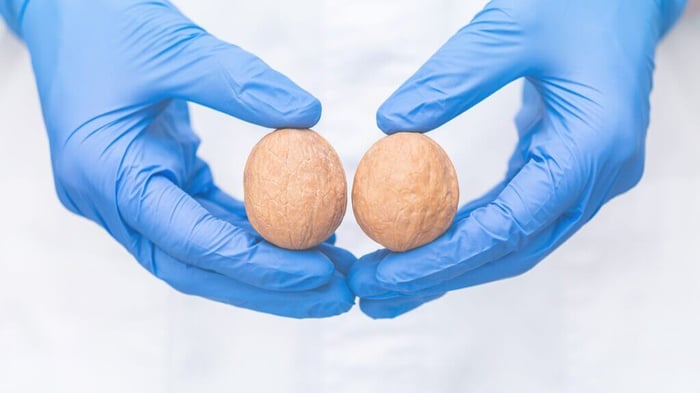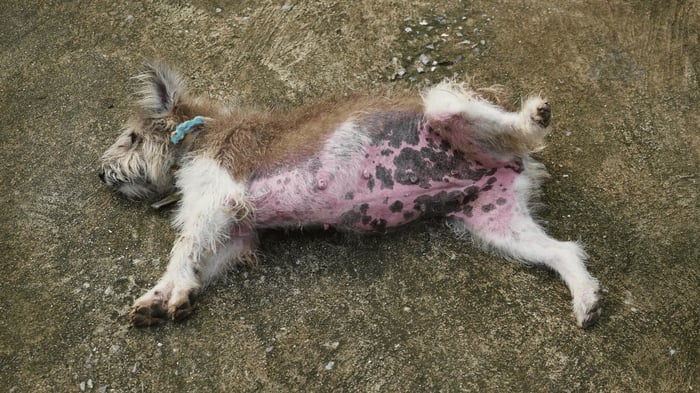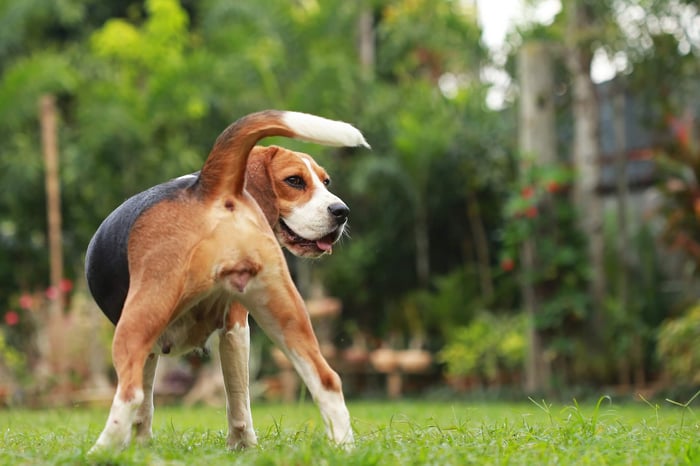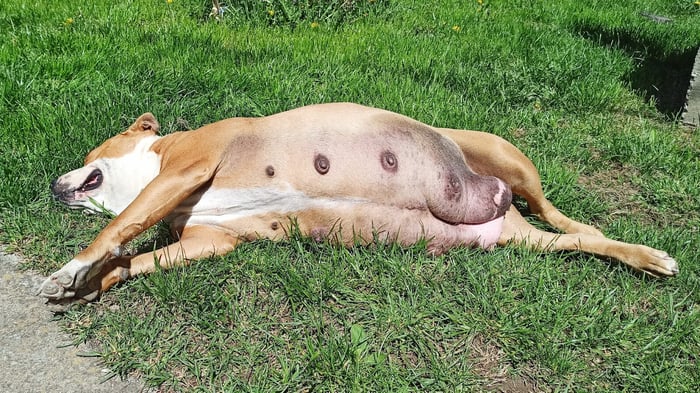If you have a male puppy, you may be wondering how to make a dog’s testicles drop. Particularly, if you want to breed your dog later, or if you’ve nervous that one testicle has dropped and not the other. You may also be worried about health problems your male puppy may face if they have one retained one or both testicles.
Dog owners may not think much of it, but canine testicles drop from the abdomen into the scrotum soon after birth. Some male dogs, however, may develop undescended testicles, even if you do everything right, like giving them a proper diet, canine vitamin supplements, and health care.
In this article, we’ll explore the process of canine testicle descent and the importance of it happening correctly. Having consulted Dr. John Huston’s Descent Of The Testis, we’ll walk you through what you need to know about making your dog’s testicles drop.
So, What Can I Do To Make My Dog’s Testicle Drop?
The best way to remedy undropped testicles in dogs is to consult your vet for surgical solutions. Retained testicles (called cryptorchidism), may prove to be a tricky medical procedure, depending on where in the abdomen they are. Some larger breeds may take slightly longer for their testicles to drop, meaning all you need to do is wait.
Some advice on the internet may suggest massaging the area to increase blood flow, or giving your dog supplements. The trouble is that since this is a genetic disorder home remedies to force the testicles to drop are not likely to be effective. In some cases, they could even be dangerous.
What Causes Testicles to Drop? Understanding Canine Testicle Descent Stages

Before we dive into the specifics of making a dog’s testicle drop, let’s take a moment to understand how it develops in the first place. Male puppies are born with their testicles up in their abdomen.
These testicles are not visible from the outside of the puppy’s body. As the puppy grows, the testicles begin to develop and make their way down into the scrotum. The descent happens in two stages.
In the first stage, which can happen soon after birth or by three weeks of age, the testicles drop from the abdomen into the top of the scrotum. During this stage, the testicles are still small and not fully developed.
In the second stage, which can happen between six weeks and six months of age, the testicles descend the remainder of the way to the bottom of the scrotum. During this stage, the testicles continue to grow and develop until they reach their full size.
This descent is important for two reasons:
- Proper sexual maturity down the line.
- Exposing the testicles to temperatures a few degrees cooler than their internal body temperature. This drop in temperature is critical for sperm production; overheated testicles can lead to infertility or other reproductive problems.
Both stages are necessary for proper testicle development and function. Dogs that don’t have either or both testicles dropping into the sacs are called cryptorchids. These dogs have retained testicles. A condition also referred to as cryptorchidism. Unilateral cryptorchidism means on retained testicle and bilateral cryptorchism means both testicles that have not dropped.
This video below is a great example of retained testicles in dogs within the veterinary practice.
How Do I Know If My Dog’s Testicles Have Dropped?
To determine if your dog’s testicles have not dropped (cryptorchidism), you can perform a simple physical examination. Here’s how:
- Gently feel the scrotum: The scrotum is located between the dog’s hind legs. If both testicles have descended, you should be able to feel two distinct, round, and firm testicles within the scrotum.
- Observe signs of testicles absence: If you cannot feel any testicles, it may indicate that they have not descended.
And, How Can I Help My Dog’s Testicles Drop?
The best, most assured way to help your dog’s testicles drop is to consult your vet on the matter. You can seek medical help as soon as you notice that your dog doesn’t have visible testicles by about the third month after birth.
Several dog conditions like orange urine, leg shaking, and some behavioral issues may have home remedies depending on the cause. However, it’s best to start with the vet concerning retained testicles because there is little you can do at home to force this process.
Neutering is often the best option for undropped testis, particularly if your dog is past six months of age. This is beneficial also because Cryptorchid dogs should never be bred to avoid passing down the trait through the line.
How To Make Your Dog’s Testicles Drop at Home: Is It Possible?
Although you may come across some blogs or people claiming that you can help a dog to drop their testicle by pulling on it, it’s highly unlikely. Most times, the retained testicle is simply too far up to just pull it. Trying to pull it out can also injure your dog internally.
Even surgery for undropped testicles can be more complicated than traditional neutering, depending on how far up they are. However, you can help your dog at home after surgery by offering post-treatment care like rest.
What Causes a Dog’s Testis Not to Drop: Factors Affecting Testicle Descent
Check out this video of a dog about to receive treatment for retained testicles
Several factors can affect testicular descent in dogs, including genetics, hormonal issues, and nutrition, affecting health. Of these, genetics is arguably the most significant cause of undropped testicles in dogs.
1. Genetics
While Cryptorchidism (retained testicles) can happen to any dog, it’s more common in more dogs than others. Small breeds like Teacups, such as Teacup Havanese and Goldendoodles, and other smaller breeds like Chihuahuas are at higher risk of retained testicles. In fact, studies show that smaller dogs are about 2.7 times more likely to develop the condition.
2. Hereditary Issues
X-linked autosomal recessive trait where parents with issues on the X chromosome causing retained a retained testicle are likely to pass it to offspring. This is why even fertile dogs with one testicle must not be bred because their little ones may end up the same way.
Do Hormonal Problems Cause Undescended Testicles?
Contrary to popular belief, hormonal imbalances rarely affect testicle descent. Research has shown that neither a lack or excess of hormones like testosterone, estrogen, and LH is likely to cause the issue. This is why dogs with a retained testicle soon show signs of wanting to mate.
When to Be Concerned About Undescended Testicles
Noticing your dog having undescended testicles warrants immediate concern. A dog’s testicles should have descended by 3 to 6 months of age, so owners should keep an eye on this timeframe.
If you suspect your dog’s testicles have not dropped within this by 6 month, it’s important to seek professional help to address the issue. Your veterinarian can perform an examination and determine if there is an underlying issue that needs to be addressed.
What Happens When A Dog’s Testicles Don’t Drop? The Dangers Of Undescended Testicles In Dogs
As we mentioned earlier, there are a few good reasons why proper testicle descent is important for dogs. Most importantly, retained testicles mean a much greater risk of testicular cancer. Seminomas and sertoli cell tumors are two very common cancers that affect dogs with undescended testicles.
In addition, undescended testicles can cause torsion, which is a painful twisting of the testicle that can lead to tissue damage and even death of the testicle.
The importance of testicle descent goes beyond just reproductive health, as late descent can also affect a dog’s behavior. Dogs with undescended testicles may exhibit aggressive or dominant behavior, which can make them challenging to train and handle.
This is because undescended testicles can cause an imbalance in testosterone levels, leading to behavioral issues.
Diagnostic Tests & Treatment for Undescended Testicles
Diagnostic tests for undescended testicles can include ultrasounds, X-rays, and blood tests to assess hormone levels. During an ultrasound, high-frequency sound waves are used to create images of the inside of the body. This locates testicles and determines their size and condition.
X-rays can also be used to locate the testicles and assess their condition. Blood tests can be used to check hormone levels, which can indicate whether the testicles are functional or not.
What Are The Treatment Options for Undescended Testicles?
Treatment for undescended testicles generally involves surgery, specifically a procedure called orchiopexy. Orchiopexy involves surgically repositioning the undescended testicles into the scrotum and securing them in place.
This procedure may be performed as early as six months of age or earlier if there are other problems like inflammation or infection in the area. In some cases, if the testicle is non-functional or there is a high risk of cancer, it may need to be removed entirely. Post-care treatment involves allowing your dog plenty of rest and sticking to medications.
How Much Does Dog Undescended Surgery Cost?
Orchiopexy costs range depending on the hospital but are typically $300 to $500. However, the price can go much higher because neutering or operating on a dog with retained testicles can be complicated. This is especially true if the retained testes are way above approaching the abdomen.
How to Prevent Undescended Testicles in Future Generations
1. Responsible Breeding Practices
2. Early Detection and Intervention
3. Educating Others About Canine Testicle Health
Frequently Asked Questions (FAQs)
Can a Dog With One Testicle Reproduce?
Can My Dog’s Testicles Go Back Up?
At What Age Should A Dog’s Testicles Drop?
At Late Can A Dog’s Balls Drop?
How Can I Make My Dog’s Balls Drop Naturally?
At What Age Should You Neuter A Dog with An Undescended Testicle?
Final Thoughts
Canine testicle health is an essential topic for all dog owners to understand. Proper testicle descent is critical for reproductive health, as well as appropriate temperament. If you suspect your dog’s testicles haven’t descended as they should have, vital to seek professional help such as Orchiopexy.







